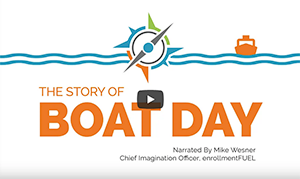A lot of enrollment professionals exert energy and effort looking for a silver bullet to solve the enrollment woes of their institution. From new vendor solutions to reorganization of office structure, everything is considered. Often, desperate times call for desperate measures, and expensive consultants are hired to correct the problems, often without successful outcomes.
Strategic Enrollment Management takes into account financial aid. Especially with the introduction of the FAFSA Simplification Act, if you have not delved into financial aid, or don’t really understand your packaging philosophy, and how and why it was built, you are almost guaranteed less than ideal enrollment performance.
DIAGNOSING HIGHER ED ENROLLMENT ISSUES VIA FINANCIAL AID ANALYSIS
One of the best things enrollment managers can do is garner qualified experience in the area of financial aid. While many financial aid directors are great at what they do from an operations standpoint—they know the regulations and Title IV Policy—they are not always equipped to think about big picture policy that impacts the overall strategy of enrollment and how that equates to enrollment management.
PACKAGING POLICY
When was the last time you really looked at your packaging policy in terms of your enrollment profile? Are you using a matrix to award merit-based financial aid? Have you just been using the same matrix and packaging policy year-after-year because it exists and you assume it is performing? Like everything else in enrollment management, it is all about the data and analysis. It is imperative that you examine your packaging policy and matrices every year and ask hard questions about their impact on your enrollment.
CELL ANALYSIS
How often are you doing cell analysis and moving key dollars to cells where you want more enrollment? Or, better yet, moving money away from cells where you are performing well, but almost wish you weren’t. You know what I am talking about—our test score averages still matter!
GET INVOLVED & STAY UP TO DATE
It is critical that financial aid teams possess the insights and benefits that come from having broad expertise not only in regulatory necessities but also a deep understanding of the role financial aid plays in determining overall enrollment success. If financial aid and enrollment management do not already share leadership, serve as an advocate for making that change, and in the meantime, find ways to enhance and facilitate a strong partnership between both departments. If you are overseeing financial aid, you need to be knowledgeable about how to calculate your discount rate, not only for each student you package, but also, for the cohort and the overall enrollment. Do you do this dynamically as each student is packaged? Do you run daily and weekly reports and review them with your financial aid director? And, when was the last time you actually attended NASFAA?
Some basic concepts to consider as an enrollment manager are actually things that we instinctively know, but aren’t addressed in the course of our busy schedules because they fall lower on the priority list of fires to extinguish. To avoid this, set aside intentional planning time to review your aid policies and how they align with the mission of your institution. This should be done annually, and key reports should be built and examined weekly. You should be spending about 20-25% of your time as an enrollment manager in the world of financial aid. You should be talking about it at the top of your list in cabinet meetings, so that your president understands its importance and impact.
As you begin your annual planning, ask a series of pertinent questions like:
- Are there students enrolled who could qualify for financial aid, but have not applied?
- How does our packaging policy reward and retain students to persist to graduation?
- How are student debt levels impacting their ability to stay enrolled?
- Are there students who don’t even consider my school because the perceived cost is too high?
AID STRUCTURE
Review how you are structuring your aid. Is it focused more on merit, or need? What categories of aid are you writing into your policy? Considering academic qualifications, special talents, need, geography and, of course, cost are all important aspects. Ensure that you are considering how you are handling outside scholarships, stacking of various internal aid elements like merit and athletic aid, and how the cost of tuition/comprehensive fee is set by your Board. Try to make sure that you have a voice in the process at the Big Table. One way to get there is to offer to present an overview of the process to help educate your Board members.
No matter what you have been doing in the past, now is the time to get serious about understanding more about your financial aid process and how it is, or is not, impacting your enrollment. Critical analysis can help you focus on where you need to make change and what you need to ask for from the institution moving forward. And, most importantly, involving your financial aid director will make stronger alliances within your team—who secretly, and often, feel left out of the conversation. This is one way to move toward real strategic enrollment management and focus less on that silver bullet.
Related Articles
Higher Ed SEM Articles | Financial Aid Tips | enrollmentFUEL
Have you experienced a reluctance by your financial aid office to award financial aid to...
Mid-year Pivot?
We have passed the fall mile markers. September/October travel season. Check. Thanksgiving. Check. ...
5 Critical SEM Study Considerations | Higher Ed Blog Articles
In these unusual times, colleges and universities face complex challenges. The educational...




